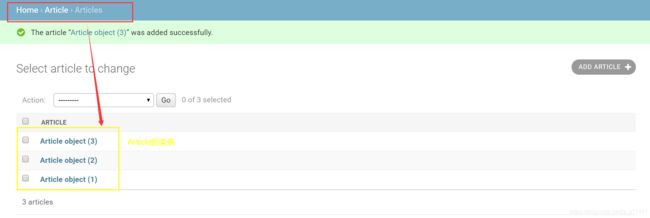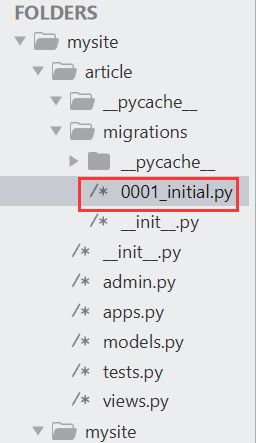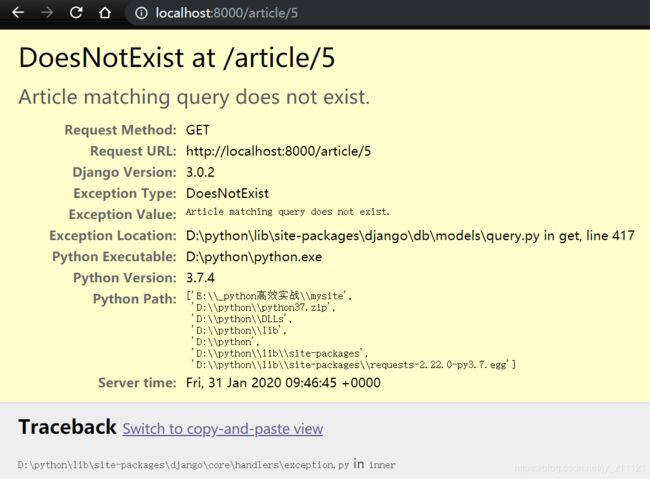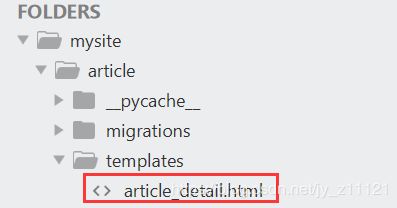Django实战(入门)
大体步骤总结
建立项目
django-admin startproject mysite
建立应用
python manage.py startapp article
建立模型
- 在
mysite/settings.py中找到INSTALLED_APPS数组,向其中添加应用article - 在
djangosite/app/models.py中新建一个模型类 - 生成数据移植文件 makemigrations
python manage.py makemigrations article - 移植到数据库 migrate
pythn manage.py migrate
管理界面
python manage.py createsuperuser
启动服务器
python manage.py runserver
其他内容讲解
1. 获取实例对象的唯一标识
2. 输入网址的同时传入页面所需的参数
在article/views.py中定义一个函数article_detail:
from django.shortcuts import render
from django.http import HttpResponse
# Create your views here.
def article_detail(request, article_id):
return HttpResponse("文章ID:%s" % article_id)
在mysite/urls.py中添加URL映射:
from django.contrib import admin
from django.urls import path
from article.views import article_detail
urlpatterns = [
path('article/' , article_detail, name="article_detail"),
path('admin/', admin.site.urls),
]
3. objects
模型的objects对象用来获取或操作模型实例。常用方法如下:
模型名.objects.get(条件) # 根据条件获取指定的模型实例
模型名.objects.all()
模型名.objects.fliter(条件)
示例:
from django.shortcuts import render
from django.http import HttpResponse
from .models import Article
# Create your views here.
def article_detail(request, article_id):
# 获取实例对象
article = Article.objects.get(id=article_id)
# 查看实例对象的属性值
return HttpResponse("ID为%s的文章的标题为:%s,对应的文章内容为:%s" % (article_id, article.title, article.content))
from django.shortcuts import render
from django.http import HttpResponse
from .models import Article
# Create your views here.
def article_detail(request, article_id):
try:
article = Article.objects.get(id=article_id)
except Article.DoesNotExist:
return HttpResponse("指定文章不存在!
")
return HttpResponse("ID为%s的文章的标题为:%s,对应的文章内容为:%s" % (article_id, article.title, article.content))
4. 使用模板文件
from django.shortcuts import render
from django.http import HttpResponse
from .models import Article
from django.shortcuts import render
# Create your views here.
def article_detail(request, article_id):
try:
article = Article.objects.get(id=article_id)
context = {}
context['article_obj'] = article
except Article.DoesNotExist:
return HttpResponse("指定文章不存在!
")
#return HttpResponse("ID为%s的文章的标题为:%s,对应的文章内容为:%s" % (article_id, article.title, article.content))
return render(request, "article_detail.html", context)
<html lang="en">
<head>
<meta charset="UTF-8">
<title>Documenttitle>
head>
<body>
<h2>{{ article_obj.title }}h2>
<hr>
<p>{{ article_obj.content }}p>
body>
html>
运行效果:

views.py进一步优化,优化的目的是——当访问不存在的对象时,显示404:
from django.shortcuts import render, get_object_or_404
from django.http import HttpResponse
from .models import Article
from django.shortcuts import render
# Create your views here.
def article_detail(request, article_id):
article = get_object_or_404(Article, pk=article_id)
context = {}
context['article_obj'] = article
return render(request, "article_detail.html", context)
5. 获取所有实例对象
templates/article_list.html:
<html lang="en">
<head>
<meta charset="UTF-8">
<title>Documenttitle>
head>
<body>
{{ article_obj }}
<hr>
{% for article in article_obj %}
<p>{{ article.title }}p>
{% endfor %}
body>
html>
views.py:
from django.shortcuts import render, get_object_or_404
from django.http import HttpResponse
from .models import Article
from django.shortcuts import render
# Create your views here.
def article_list(request):
articles = Article.objects.all()
context = {}
context['article_obj'] = articles
return render(request, "article_list.html", context)
mysite/urls.py:
from django.contrib import admin
from django.urls import path
from article.views import article_detail
from article.views import article_list
urlpatterns = [
path('article/', article_list, name="article_list"),
path('article/' , article_detail, name="article_detail"),
path('admin/', admin.site.urls),
]
效果:

改进templates/article_list.html:
<html lang="en">
<head>
<meta charset="UTF-8">
<title>Documenttitle>
head>
<body>
{% for article in article_obj %}
<a href="/article/{{ article.pk }}">{{ article.title }}a>
等价于:
{{ article.title }}
{% endfor %}
body>
html>

点击超链接,可转入相应的具体内容的网页。如点击“test3”:
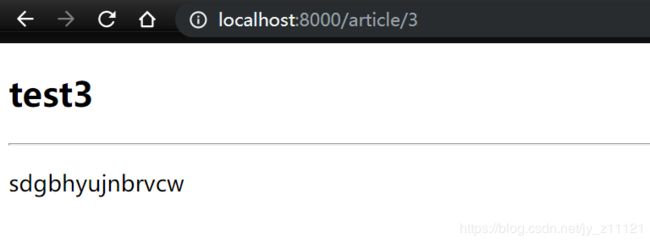
6. 定制管理后台界面
在article/models.py中添加__str__(self)函数:
from django.db import models
# Create your models here.
class Article(models.Model):
title = models.CharField(max_length=30)
content = models.TextField()
def __str__(self):
return "" % self.title
效果如下——用于定制后台界面中实例对象的显示格式:
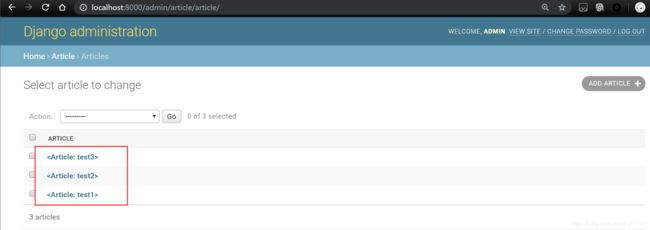
更改article/admin.py文件内容:
from django.contrib import admin
from .models import Article
# Register your models here.
class ArticleAdmin(admin.ModelAdmin):
list_display = ("id", "title", "content")
admin.site.register(Article, ArticleAdmin)
效果如下:

再添加一行代码:ordering = ("id", )(后面有个逗号表示元组),此时页面效果为【没有此行代码时的排列效果就相当于ordering = ("-id", )】:

使用装饰器:
from django.contrib import admin
from .models import Article
# Register your models here.
@admin.register(Article)
class ArticleAdmin(admin.ModelAdmin):
list_display = ("id", "title", "content")
ordering = ("id", )
#admin.site.register(Article, ArticleAdmin)
7. 修改模型类时需要注意的问题
若对模型类进行了修改(如添加一个字段creadted_time = models.DateTimeField()),则必须执行如下两个操作:
- 生成数据移植文件 makemigrations
python manage.py makemigrations article - 移植到数据库 migrate
pythn manage.py migrate
否则,将出现如下错误:
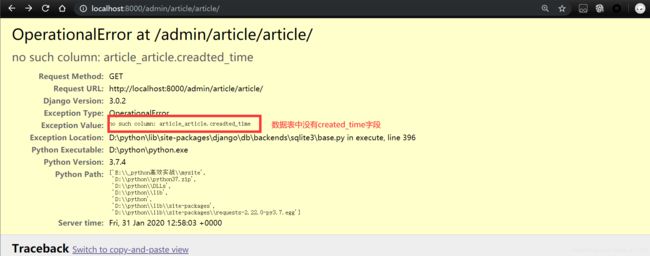
当执行python manage.py makemigrations article时,你会发现如下提示:

这是因为在新添加一个字段时,没有赋予它默认值!从上面的提示就可以看出来,我们有两张方式为它添加默认值,1是使用命令行的方式来为它赋予默认值,2是退出命令行,添加默认值参数。下面使用第一种方式:

效果如下:
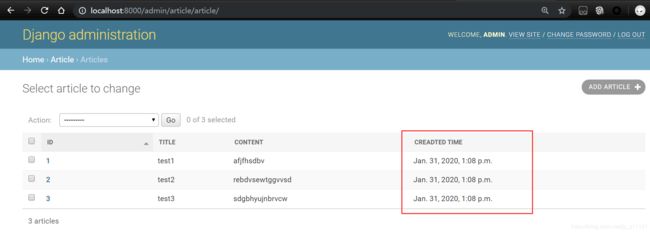
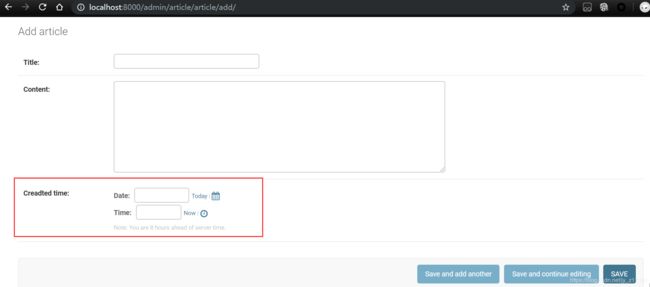
第二种添加默认值的方式:
from django.db import models
from django.utils import timezone
# Create your models here.
class Article(models.Model):
title = models.CharField(max_length=30)
content = models.TextField()
creadted_time = models.DateTimeField(default=timezone.now)
def __str__(self):
return "" % self.title
此外,对于时间类型,还有第三种方式为其添加默认值:
creadted_time = models.DateTimeField(auto_now_add=True)
# auto_now_add=True:自动设置为现在的时间,除非手动进入后台界面进行更改
再次更新模型类:
from django.db import models
from django.utils import timezone
# Create your models here.
class Article(models.Model):
title = models.CharField(max_length=30)
content = models.TextField()
creadted_time = models.DateTimeField(auto_now_add=True)
last_updated_time = models.DateTimeField(auto_now=True)
# auto_now=True:每次进行内容的更新后,此字段的值自动更新为当时的时间。
def __str__(self):
return "" % self.title
8. 为模型类设置外键
from django.db import models
from django.contrib.auth.models import User
# Create your models here.
class Article(models.Model):
title = models.CharField(max_length=30)
content = models.TextField()
creadted_time = models.DateTimeField()
last_updated_time = models.DateTimeField(auto_now=True)
author = models.ForeignKey(User, on_delete=models.DO_NOTHING, default=1)
'''
models.ForeignKey()参数解释:
author关联到User表中;
删除author时不删除User中的对应的author;
默认值为User表中主键为1的author。
'''
def __str__(self):
return "" % self.title
